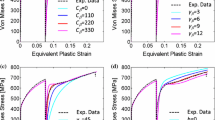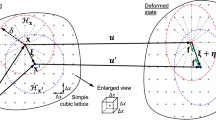Abstract
There is continuing interest in defining a fracture parameter which is capable of characterising the ductile crack growth resistance of a material under conditions of large scale plasticity. The aim of this study is to assess the capability of a number of elastic-plastic fracture parameters for the case of a C-Mn steel. The fracture parameters considered are: the crack opening displacement at the original crack tip (CTOD); the crack opening angle at the growing crack tip (CTOA); and the crack opening displacement at the growing crack tip (δa). The parameters were assessed by determining experimentally whether they were affected by changes in test specimen size and geometry in cases where there was no change in the crack tip constraint. Changes in the latter were assessed from changes in the CTOD at crack initiation (CTODi). Only δa was capable of characterising the crack growth resistance, as unlike both CTODi and δa, dCTOD/da and CTOA were dependent on specimen geometry.
Résumé
L'intérêt persiste à définir un paramètre de rupture capable de caractériser la résistance d'un matériau à la propagation ductile d'une fissure, dans des conditions de plastification à grande échelle. L'étude a pour objet d'établir la pertinence d'un certain nombre de paramètres élasto-plastiques relatifs à la rupture d'un acier CMn. On considère en particulier le déplacement d'ouverture de l'extrémité de la fissure initiale (CTOB), l'angle d'ouverture en cours de croissance de la fissure à son extrémité (CTOA) et le déplacement d'ouverture en cours de croissance de l'extrémité de la fissure (δa).
L'analyse à porté sur la réaction expérimentale de ces paramètres à des changements de taille ou de géométrie d'éprouvettes, dans des cas où il ne se produisait pas de modifications des contraintes d'environnement à l'extrémité de la fissure. Lorsque celles-ci survenaient, le CTOD correspondant à l'amorçage (CTODi) y était sensible.
II est apparu que seul δa pouvait caractériser la résistance à la croissance d'une fissure, dans la mesure où, á l'inverse du CTODi et du δa, le CTOA et la variation du CTOD en fonction de la longueur de la fissure sont dépendants de la géométrie de l'éprouvette.
Similar content being viewed by others
References
J.R. Rice, Journal of Applied Mechanics 35 (1968) 379–386.
G.P. Gibson, S.G. Druce and C.E. Turner, International Journal of Fracture 32 (1986) 219–240.
G.P. Gibson, “Characterisation of Ductile Crack Initiation and Growth in Mild Steel“, PhD thesis, London (1986).
I.D. Lewis, R.F. Smith and J.F. Knott, International Journal of Fracture 11 (1975) 173–183.
G.P. Gibson and S.G. Druce, A study of elastic-plastic fracture parameters through the thickness of fracture toughness specimens using silicone-rubber crack impressions, report No. AERE R10815, AERE Harwell (1983).
A.A. Willoughby, P.L. Pratt and C.E. Turner, International Journal of Fracture 17 (1981) 449–466.
S.J. Garwood and C.E. Turner, International Journal of Fracture 14 (1978) R195-R198.
R.M. McMeeking, Journal of the Mechanics and Physics of Solids 25 (1977) 357–381.
S.J. Garwood, in ASTM STP677 (1979) 511–532.
J.N. Robinson, International Journal of Fracture 12 (1976) 723–737.
R.M. McMeeking and D.M. Parks, ASTM STP668 (1979) 175–194.
C.F. Shih, W.R. Andrews, H.G. deLorenzi, M.D. German, R.N.Van Stone and D.F. Mowbray, Methodology for plastic fracture, final report, EPRI NP-1735, Project 601–2, EPRI, USA (1981).
G.P. Gibson and S.G. Druce, in ASTM STP 856 (1985) 166–182.
Author information
Authors and Affiliations
Rights and permissions
About this article
Cite this article
Gibson, G.P., Druce, S.G. An assessment of various crack tip displacement based elastic-plastic fracture parameters to characterise ductile crack growth resistance. Int J Fract 35, 139–151 (1987). https://doi.org/10.1007/BF00019796
Received:
Accepted:
Issue Date:
DOI: https://doi.org/10.1007/BF00019796




